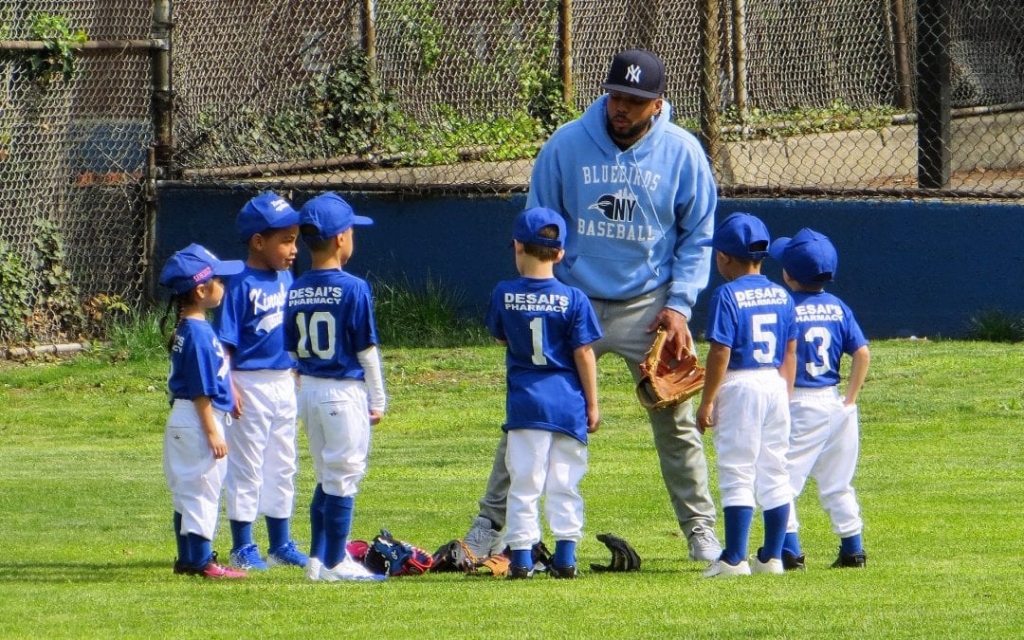Matthew Cole stands in the batter’s box, slowly waving his bat in anticipation of the upcoming pitch. As he stands there, he is drowning in a torrent of ‘helpful instruction’, courtesy of his coaches, the gaggle of parents behind the backstop and even his buddies in the dugout. “Get that elbow up!” “Open your stance!” “Keep your head in there!” “Step right at the pitcher!” “Close your stance!” “Hold your hands higher!” “Don’t step in the bucket!”
Despite the fact that some of that instruction might be good advice (some of it is truly awful), it is having an adverse effect on young Mr. Cole. How can that be? Young hitters need instruction, don’t they? Yes, but it must be sound instruction, delivered in measured doses and at the proper time. The barrage to which he is being subjected runs the gamut from good to terrible. Which should he consider and which should he reject? More importantly, instruction of this nature should not be given while the student is facing live pitching during a game. It should be confined to the batting cages or the practice field.
Sure, everyone means well. They all want Matthew to succeed in his at bat. Nevertheless, they are programming him for failure. In his book, The Psychology Of Baseball, Mike Stadler makes the following comments regarding a sports phenomenon known as ‘choking’: “Research suggests that choking may emerge from a greater-than-usual self-focus … Attention to a well-practiced, automatized skill is harmful to performance.”
Citing a study conducted with Division I college players, he noted that those hitters had greater success when their attention was directed externally, and less success when it was directed internally. Self-focus, or paying undue attention to one’s body mechanics during an activity, is detrimental to athletic achievement. Still not convinced? What is the oft-repeated phrase you hear in an interview when a hitter is ripping the cover off the ball? “I’m seeing the ball well,” he’ll say. That means that he is picking it up early; quickly and accurately reading the rotation, velocity, direction and location. Now that leads to success in hitting … and it’s all external. The swing itself is a well-practiced, automatized skill.
To give you an example of an internal focus, let’s try an experiment. Start a finish nail in a two-by-four. Now – focus your attention on your hand upon the hammer handle as you swing it and attempt to drive the nail. Did you bend a few? Sure you did, and I’ll tell you why. Having the proper FOCUS is fundamental to success in nearly any pursuit. If your focus is upon the nail, chances are you’ll drive it successfully. But even a skilled carpenter will fail if his focus is misdirected.
Some might argue that receiving instruction while at the plate is a simple case of multitasking; people can do more than one thing at a time. Sorry, friend, but that simply isn’t true. Yes, you can walk and chew gum at the same time, but those are two activities for which you have developed the muscle memory. Those are well-practiced, automatized skills. Your attention, on the other hand, can only be on one thing. When someone is multitasking, his attention is diverted rapidly back-and-forth between the two tasks. He does not and cannot focus on two different activities at the same time.
In the case of our young hitter, his attention has been diverted from the pitcher’s mound to the banter taking place all around him. He is engaged in the process of sorting through that advice, based upon who is giving it. Now he will redirect his focus internally in an attempt to correct all of these alleged problems in his swing. That’s a recipe for disaster. Do you really want him standing up there doing those mental gymnastics? Or would you rather have him “seeing the ball well”?
Coaches: don’t coach your hitters while they are in the box. Resist that temptation and make sure that the entire team and all team supporters follow your lead. Your guys will enjoy much greater success. Prepare them prior to the game. Speak with them in the dugout if need be, but make sure that their attention is focused upon the right thing – the baseball. See it and hit it. The same goes for pitchers, and for the same reasons. If you are constantly critiquing his every move on the mound, his attention will be focused internally, rather than externally, where Matthew is slowly waving that bat.
Yes, in-game skills coaching leads to self-focus and distraction. But there are other distractions at the little league field. Let’s look at a few.
It goes without saying that the treasure trove of concession treats moms and dads shuttle to the dugout is a huge distractor. (Oh, yeah, I’m meddling now.) Sure, the kids love the nachos, hotdogs and other tasty delights, and for the same reason that dad enjoys drinking a beer while he’s in attendance. But let’s face it – it’s not a picnic, it’s a baseball game and no one will starve to death in the two hours it takes to play one. Some water or even a sports drink on a hot afternoon is a good idea. I’m not a fan of sunflower seeds, because they tend to be a distraction as well. But one thing is for certain – the heavy hors d’ oeuvres are a problem. Leave them alone until after the game.
The next distractor on my list will probably surprise you. They are the hitting aids and stations that coaches set up behind the dugout. “Are you kidding,” you ask, “what could possibly be wrong with a little BP?” Nothing, really … at the proper time. The proper time would be prior to the game, not during. That’s when you should set up your nets, your batting tee, wiffle balls – whatever it is you use for pregame batting practice. When you are finished and before the game begins, tear those stations down and put them away. It’s time now to focus on the game and the tasks at hand. All your guys should need to do during the game to prepare for a plate appearance is take a few dry cuts in the on-deck circle.
If you don’t believe these things are distractors, spend a little time behind someone else’s dugout and watch the action. The kids peel off out of the dugout, fool around, take a few half-hearted hacks and pretty much just hang out. The hitting stick is the worst offender. It consists of a five-foot fiberglass wand with a ball shrink-booted at the end. A player or coach will swing it in a wide arc toward the hitter and the hitter will hack at it. Take a good look at those pathetic swings. Most of the time the hitter will slow his swing down just to make contact. Now be honest. Do you really think that’s helping? I don’t think so. It’s reinforcing bad swing habits and redirecting their attention away from the game. Besides, the god-awful sound it makes is distracting everyone in the park.
Another distractor, commonplace in girls’ softball, but still maintaining a presence in little league baseball, is chanting. Chanting involves the loud, often obnoxious, group recitation of a cheap rhyme or phrase. Sometimes it’s a repeated word or even a sustained yell or shout. Whatever form it takes, it is usually enacted to unnerve and distract the opposing pitcher or hitter. (For that reason, my umpires have been instructed to nip it in the bud whenever it crosses the line of civility and good sportsmanship.) Some coaches will claim that they do it to “pump-up” their team and not to bother the opposing team. That doesn’t pass the smile test. Ironically, it can have an adverse effect on the team doing the chanting. Why? It’s just another distractor, keeping them from processing the things that do require their attention. Conversely, intelligent, game-focused communication is very important on the baseball field and can reap big dividends. Have your team start doing that.
This final distractor is bound to raise the hackles on a number of coaches. I’m talking about the sacred ball bucket. It’s unthinkable to some coaches that you can have a meaningful little league game without one. From this little command center, he will touch various parts of his face and torso, communicating with his team in the secret language of signing, the pitches, plays and defense they should execute. And that’s the problem in a nutshell. His team basically stands there waiting for instructions instead of processing the game for themselves. Their attention is no longer focused on their opponent. Instead, it is focused on the coach, sitting on the ball bucket like a Buddha.
I attended a private coaching clinic in June of 2011 with Tony LaRussa and Dave Duncan. Dave, who had been a catcher in his playing days, was asked about the challenges in working with modern catchers. His response was very interesting. He said that catchers generally arrive at the professional ranks underdeveloped in terms of their ability to call and comprehend the game. The culprit? Coaches, from little league through college, who call every pitch and play. That puts things into perspective, doesn’t it?
It’s their game, folks, not ours; and it’s their time, no longer ours. Let’s dump the distractors and allow these young players to take a little ownership and control. Let’s encourage them to encounter the game and discover its intricacies. Quite often, as I’m fond of saying, little league is little more than an adult hobby. That’s where moms, dads and coaches move the little animated chess pieces around in an effort to defeat the other adults. That’s not why we’re here, friends. Sure, we all derive a certain amount of satisfaction in coaching a winner. That’s human nature and it’s good, clean fun. But that motivation should not determine how we do what we do. and it should never deprive a youngster of the opportunity he deserves.
So dump the distractors. Let your boys focus on the great game of baseball and play their little hearts out. Who knows? Maybe our beloved game will survive a few more generations.






